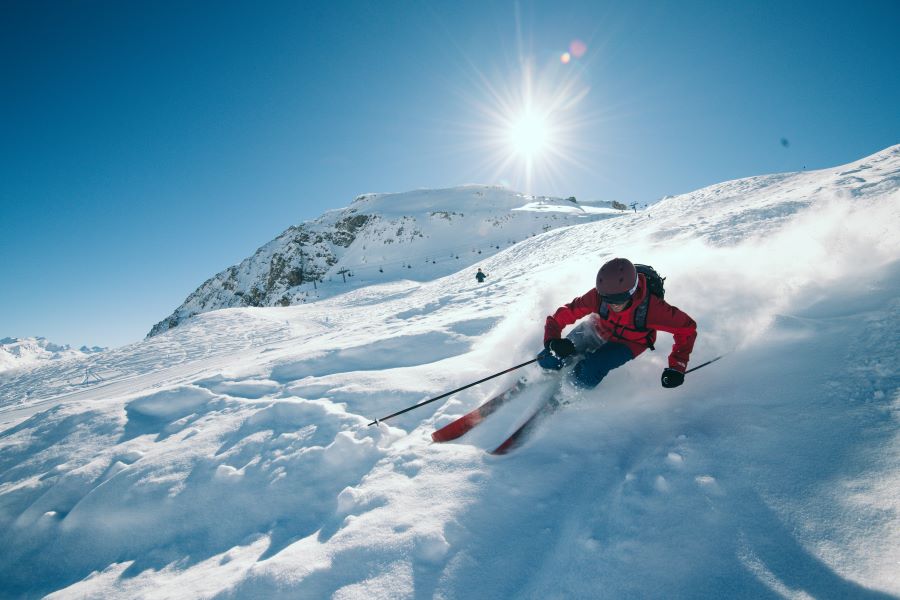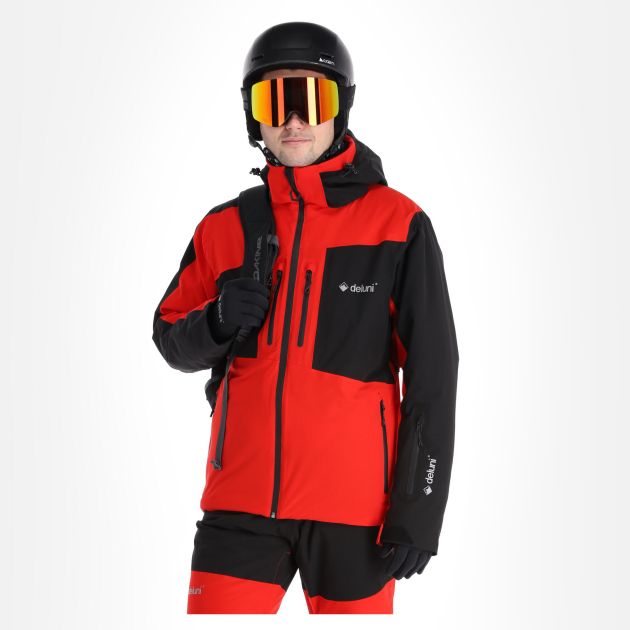
Cross-country ski tracks consist of parallel lines made on a snow surface using specialized grooming machinery. These grooming machines move, push, flatten and smooth the snow for skiing and skate skiing.
Cross country skiing requires special skills such as grooming the trails. You need to be familiar with snow movement, ski tracks and terrain. In addition to making ski tracks, groomers shape the ski base and reduce friction.
Learn more about cross country skiing
The first step to learning cross country skiing is to get the right gear. Eastern Mountain Sports can help choose the best package for your needs. This includes the right boots, bindings and poles.
Pick the best pair of skis you can afford
You should choose a ski set that's right sized for your body weight. The ski should reach the length of your legs when you stand straight (with your arms extended slightly forward) in your basic stance.

Lightweight skis can help you glide across the snow quickly and without falling. This is a great option if you want to get out in the fresh air and enjoy winter's natural beauty.
Use the shuffle.
To learn the basics of kick-and-glide skiing, you can tuck your pole tips under your armpits. This activates your core muscles and helps you keep your balance on the ski.
Repeat this motion until you can do it smoothly and slowly. When you feel comfortable with the basic shuffle and glide, add a poling motion, which moves your ski pole tips straight down into the snow.
A poling motion can be a great technique to improve your skiing and strengthen your muscles. This is an excellent technique that beginners can learn, and it can improve your overall skiing performance.
Use the right technique to match your skill level
There are three basic techniques for cross country skiing: touring, classic and skating. Each technique uses a different set to aid you in your technique on the different surfaces you ski on.

Touring skis can help you glide easier on a smooth surface while classic skis can help you ski faster over steeper slopes or through deeper snow. Skating skis will help you speed up over a softer surface, while classic skis are more for beginners and beginner-intermediate levels of skiing.
As you get more proficient and confident, start with a flat track that is easy to navigate. Then move on to more difficult trails. When you are skiing on cross-country ski tracks, be aware of motor vehicles and trail groomers. Also, make sure you get out of the way of any vehicle coming your way.
FAQ
What documents should I keep handy when traveling?
To make it easy to find important documents on the road, keep copies at home. Keep a backup of your passport and driver's licence, as well as any credit card information, if you intend to use an ATM.
A photocopy is always a good idea. This can be used to verify your identity, if necessary.
Do not forget to include copies and reservation confirmations. These will help keep you organized and allow you to plan your trip.
This should be in addition to the original flight ticket and hotel reservation details. You'll be able contact someone back home in case you need them.
Also, don't leave valuables unattended. It's a good idea to keep valuables safe and secure by storing them inside your luggage or on a money belt.
You can avoid expensive loss by checking your baggage before you travel.
Remember: It's always safer to keep things simple than to try to over-plan everything.
Let's just be relaxed and enjoy the journey!
Which countries are known for their best food?
Food varies from country to country. It's therefore difficult to identify the best countries for food.
However, we can tell which countries have the best food!
The top three countries, according to TripAdvisor users, are:
-
Italy - Italy is voted number one by TripAdvisor users due to its delicious food.
-
France - France was ranked second because of its rich culture and cuisine.
-
Spain – Spain came third due to its wonderful weather and beautiful beaches.
How much luggage do I need?
The length and type of trip will dictate how much luggage to take. Hand baggage is usually limited to 20 kg if you travel by plane. You will need more space if you travel by train or bus.
You will receive a form with all the details about your flight when you arrive at airport. This form will ask for information such as your baggage weight and if you require assistance to check them in.
This must be done before you leave your home. You might find yourself stuck waiting in line for hours as everyone else inspects their luggage.
Because you never know what could happen, it is better to travel light. You won't be able to use your bag if it gets lost.
What's the first thing you should do when you arrive at your travel destination?
It is a good idea to have a plan for when you get to a destination. It lets you know what's expected and where to go.
It is important to plan ahead so you don't forget anything.
For instance, if your trip to a city lasts more than one hour, research which landmarks, museums, and parks you'd like.
A map of the area is a great way to start researching the region's past.
How long does it take for you to fly between countries?
The distance between two airports and the weather conditions affect the time taken to fly.
The average flight time is approximately 3 hours.
The actual flying time will depend on several factors including the airline, the aircraft type and delays at the airport as well as weather conditions.
Are you worried about losing something while you're on the road?
Yes, I often forget stuff. This happens most often when I'm on a brief trip. But I have everything with I, so I never run low.
For example, I always have my passport with me. And I always check whether I have enough money when I buy tickets.
I also keep my phone charged. To store any other items, I keep them in a small bag.
Statistics
- Alcoholic beverages with 24% alcohol or less are not subject to limitations in checked bags. (tsa.gov)
- According to Maori legends, this park holds 14 fjords that were all carved by a giant stonemason with an adze. (busytourist.com)
- Pack sweaters, jackets, and underwear in reusable compression bags creating up to 75% more space in your luggage. (wikihow.com)
- No Checked Bags: No Alcoholic beverages with more than 70% alcohol (over 140 proof), including grain alcohol and 151 proof rum. (tsa.gov)
- Alcoholic beverages with more than 24% but not more than 70% alcohol are limited in checked bags to 5 liters (1.3 gallons) per passenger and must be in unopened retail packaging. (tsa.gov)
External Links
How To
How to plan your next vacation
Planning a trip involves many things like booking flights, hotels, car rentals, activities, etc. This includes important considerations like budget, destination and weather forecast.
These are important points to remember when planning your next vacation.
We have created a step to guide that will help you plan your next trip. This guide has been compiled using customer feedback as well as our own experience. We hope you find this guide helpful and easy to follow when planning your next vacation.
Steps:
-
Plan your Budget - Planning your budget is one of the most important steps in preparing for a trip. Before you can start planning where and what you will do, you must first know how much you are willing to spend. You might have to cancel your plans if you don't have enough money.
-
Book Your Tickets - Once you've decided on your budget and set your priorities, booking your flight tickets is the first thing that you should do. Be sure to get the lowest price flight deal. In addition, make sure you check whether there are any special offers for certain seasons. These deals could help you save a lot of cash.
-
You can choose your destination - Once you have purchased your ticket, you need to decide where you would like to go. Multiple factors come into play when choosing your destination, including location (where you're going), climate (what season to visit), culture (how friendly people are), and cost (how affordable it is).
-
Finding Accommodations - Once you have chosen your destination, it is time to find accommodations. You have many accommodation options, from hostels and luxury suites to choose from. It all depends on what you want and how much space you have. A hotel is not the best choice if you want to be close to the city centre. You may prefer quieter areas away from the crowds and a homestay could be better suited for your needs.
-
Select Activities & Attractions. After you have chosen your accommodation, now it's time to choose the activities and attractions that will be included in your itinerary. Depending upon the length of your stay you have two options: choose just a few activities, or add many more to your itinerary.
-
Plan Your Trip - Once you have decided on the attractions and activities you want to include, you can now plan your itinerary. A fixed schedule will ensure that you get the best value for your trip. But, it's possible to enjoy your trip more if your schedule is flexible.
-
Create itinerary – This allows you to organize all of the details for your trip. You should list all the details, from flights to accommodation to activities to restaurants.
-
Research Online - Do your research online before you travel. You can read reviews and testimonials about other destinations to get their opinions. This will help you plan.
-
Pack Lightly - One of the biggest mistakes people make when packing is bringing too many clothes. Try to bring just three sets of clothes instead of five. Consider bringing clothing that's appropriate for the region.
-
Be prepared. Be prepared before you set off on your trip. You don't want to waste time searching for important documents while you're still in transit.